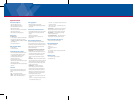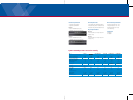
Specifications
Standard Compliance
• IEEE 802.3 10Base-T Ethernet
• IEEE 802.3u 100Base-TX Ethernet
• IEEE 802.ab 1000Base-T Ethernet
• IEEE 802.3x Flow control
• IEEE 802.1p Class of service, priority protocols
• IEEE 802.1Q VLAN tagging
• IEEE 802.3ad static port aggregation
Performance
ES-1528/ES-1552
• 12.8/17.6 Gbps non-blocking switching fabric
• Switching Forwarding Rate 9.6/13.1 Mpps
(1488000 pps/1000Base-T/1000Base-X, 148800
pps/100Base-TX)
• Wire-speed performance
MAC and Packet Buffer
• 8 K MAC entries
• 512 KB Packet Buffer
Traffic Management and QoS
• Rate Limiting: Port-based bandwidth control
with 7 grades (64 kbps, 256 kbps, 1 Mbps,
10 Mbps, 64 Mbps, 100 Mbps, 1 Gbps)
• Port-based egress traffic shaping
• Broadcast Storm Control
• Congestion control on all ports
• IEEE 802.1p with 4 priority queues per port for
different types of traffic
• WRR (Weighted Round Robin)/SPQ scheduling
algorithm
Auto VoIP
Auto VoIP module matches VoIP streams and
assign the highest priority for following VoIP
packets
• SIP — Session Initiation Protocol
• MGCP — Media Gateway Control Protocol
• SCCP — Skinny Client Control Protocol
Link Aggregation
• IEEE 802.3ad static port aggregation
• Up to 6 aggregation groups, per group supports
up to 8 ports
User Security and Authentication
• Specific MAC forwarding per port: only specified
MAC addresses can access the network (Port
Security)
• IEEE 802.1Q tagged VLAN
• 256 static VLAN, up to 4 K dynamic VLAN
• Dynamic ARP
Auto DoS Attack Prevention
Denial of Service (DoS) attacks try to disable a
device or network so users no longer have access
to network resources. Auto DoS Attack Prevention
module matches attack types in switches and
prevent network outage
Types of DoS Attacks can be prevented
• Land Attacks — These attacks result from
sending a specially crafted packet to a machine
where the source host IP address is the same as
the destination host IP address. The system
attempts to reply to itself, resulting in system
lockup.
• Blat Attack — These switch result from sending
a specially crafted packet to a machine where the
source host port is the same as the destination
host port. The system attempts to reply to itself,
resulting in system lockup.
• SYNFIN Scans — SYNchronization (SYN,
ACKnowledgement (ACK) and FINish (FIN)
packets are used to initiate, acknowledge and
conclude TCP/IP communication sessions. The
following scans exploit weakness in the TCP/IP
specification and try to illicit a response from a
host to identify ports for an attack:
- Scan SYNFIN — SYN and FIN bits are set in the
packet.
- Xmascan — TCP sequence number is zero and
the FIN, URG and PSH bits are set.
- NULL scan — TCP sequence number is zero and all
control bits are zeros.
- SYN with port <1024 — SYN packets with source
port less than 1024.
• Smurf Attacks — This attack uses Internet Control
Message Protocol (ICMP) echo requests packets
(pings) to cause network congestion or outrages.
• Ping Flooding — This attack floods the target
network with ICMP packets.
• SYN/SYN-ACK Flooding — This attack floods the
target network with SYN or SYN/ACK packets.
Network Administration Security
• Password required for administrators
Network Management
• Web-based management
• SNMP v1, v2
• IP management: static IP
• RMON
• Port mirroring: supports Source/Destination/Both
port mirroring
• Cable Diagnostic
MIB Information
• RFC1213 MIB II (System, Interface)
• RFC1398 (Ether-like)






